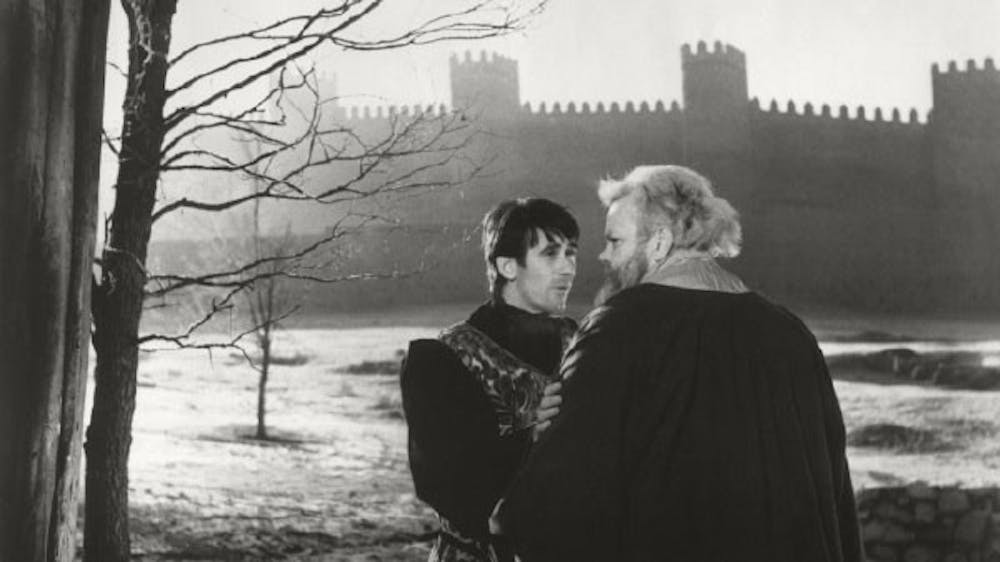To say that “Chimes at Midnight” is potentially Orson Welles’ best work is to say that it is one of cinema’s greatest achievements.
The film, celebrating its 50th anniversary, has been extensively restored for decades and opened in a limited engagement in Los Angeles and New York City on Jan. 1. This weekend, it is rolling out to Harkins Camelview 14 at Fashion Square and other theaters around America.
Welles, who is most often remembered for his debut “Citizen Kane,” deemed “Chimes at Midnight” his magnum opus, and its achievement still standouts today. Welles’ inventiveness in combining Shakespeare’s work to create a full, fleshed out narrative of his favorite underutilized Shakespearean creation and his directorial accomplishments haven’t diminished in the five decades that have passed.
“Chimes at Midnight” is an adaptation of Shakespeare’s “Henry IV Part 1 and 2” and parts of “Richard II,” “Henry V” and “The Merry Wives of Windsor.” The film follows Falstaff (Welles himself) and his escapades with close friend Prince Hal (Keith Baxter), the next in line for Henry IV’s (John Gielgud) crown.
Amid the debauchery, Henry IV’s kingdom is attacked by a rebel army led by Hotspur (Norman Rodway) and the Battle of Shrewsbury ensues. As the years go on and King Henry IV’s health deteriorates, Hal has to choose between the crown and loyalty.
As a concept, “Chimes at Midnight” is perhaps the most audacious adaptation of Shakespearean prose in film to date. Yet, Welles’ combination of the different plays never feels inauthentic or anything less than Shakespearean. The plays are combined with such fluidity and expertise that even the Elizabethan playwright himself would have been proud of the adaptation.
However, “Chimes at Midnight” brings an accessibility to the old words. Welles’ combines a clean, cohesive narrative with the most intriguing and understandable parts of the plays. And, astoundingly, Welles grabs on to the epic nature of the Battle of Shrewsbury while maintaining a simple narrative on family and friendship at the heart of “Chimes at Midnight.”
The action of that battle may be Welles’ best and most influential sequence. For six minutes raw barbarity breaks out in one of the most energetic battles in film history. The sequence is rapidly cut, providing vignettes of armored bodies fighting and falling in a brutal, but gorgeously choreographed fashion.
This carnage holds deeper meaning than the sheer spectacle of the battle, as it is potentially Welles’ own commentary on the atrocity of war. The scene served as inspiration for many battle scenes through the year and, despite its brutality, illustrates that less can be more in terms of gore. In fact, the scene is far more horrifying than the cartoonish and intentionally nauseating opening sequence in “The Revenant,” which is the antitheses of the Battle of Shrewsbury.
As often as “Citizen Kane” is regarded as a cinematographer’s masterpiece, “Chimes at Midnight” serves as the more successful and realized of the works. There is so much versatility in the camerawork, whether it be panning with a character as they deliver a monologue, perusing a battlefield or staying stationary in a tender moment.
In spite of budget constraints causing shoddy sound design and continuity errors, "Chimes at Midnight" is one of the few perfect films in American cinema. Welles recognized Falstaff’s purity and innocence, and his performance is the glue that holds together this masterpiece. “Chimes at Midnight” is hilarious, energetic and the final betrayal is heavy and affecting.
It is Shakespeare for generations that don't care for Shakespeare, and it is one of the most easily watchable films despite its age and black and white format.
Related Links:
Lesbian drama 'Carol' exceeds labels, becoming one of Hollywood's greatest love stories
After decades-long wait, 'Creed' revives genre of dramatic boxing movies
Reach the reporter at tanner.stechnij@asu.edu or follow @tannerstechnij on Twitter.
Like The State Press on Facebook and follow @statepress on Twitter.




